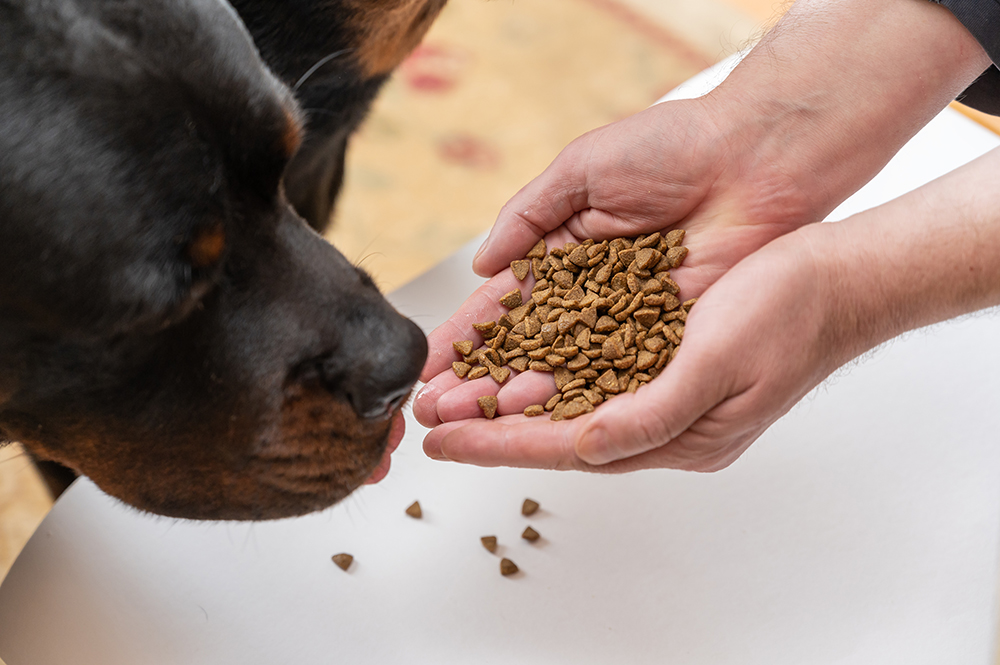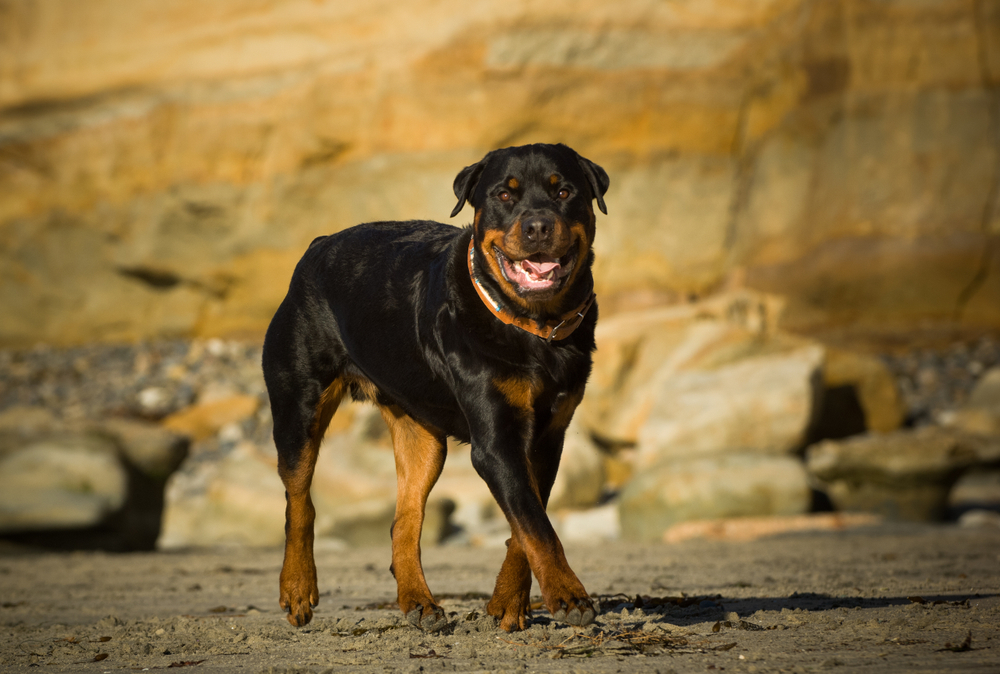Original Article: https://www.dogster.com/dog-nutrition/what-do-rottweilers-eat
Click to Skip Ahead
Rottweilers are big dogs with big appetites to match, so it’s essential to feed them appropriately to ensure they’re getting the nutrients they need to thrive. However, the number of dog food products available can make choosing the right diet feel impossible.
If you’re unsure what or how much to feed your Rottie, keep reading. We’ll help you with everything you need to know about your beautiful dog’s nutritional needs so you can make an informed decision about their diet.


What Do Rottweilers Eat?
A healthy Rottweiler’s diet isn’t any different from that of any other dog breed.
The essential components of any dog’s diet are protein, fats, carbohydrates, minerals, and vitamins. The exact ratio of these ingredients can vary depending on the manufacturer and type of food. In the “Nutritional Requirements for Rottweilers” section below, we’ll touch on how the dietary needs of Rottweiler puppies, adults, and seniors vary depending on their life stage. For now, however, let’s stick to the basics.
Rottweilers can eat wet food, dry food, or a combination of both. Both types have their benefits and drawbacks.

Wet Food Diet
The most significant benefit of wet (or canned) food is that dogs generally prefer it over dry. It is highly aromatic and more flavorful than dry food, which can make it more enticing for sick or senior dogs with little appetite. Due to the increased moisture content, canned food can also help promote satiety, which can be helpful when trying to manage your Rottie’s weight.
However, wet food is much more expensive than dry food and cannot be left sitting out at room temperature for long, so it has to be served at mealtimes. These factors can make canned food inaccessible to dog owners on a budget or those with strict schedules.
Dry Food Diet
A dry food diet is often much more financially feasible than wet food, it boasts a much longer shelf life, and may be more convenient to feed as it can be left out all day for Rotties that like to graze.
The downsides of kibble are that it has lower palatability and may be more likely to contain preservatives, which help maintain that extended shelf life.

Combination Diet
A combination diet provides Rottie’s with the best of both worlds. However, when mixing both types of food, it’s essential to ensure your pup is still getting the proper portions to prevent overfeeding. Your veterinarian can help you determine exactly how much dry and wet food to offer your dog to keep them at an ideal weight.


Nutritional Requirements for Rottweilers
Nutrition is a powerful tool that can prove helpful in all stages of a Rottweiler’s life. The proper diet can be used to maintain health status, prevent health conditions, and, in some cases, even manage some diseases.
The most important consideration when feeding a Rottie is choosing food that matches their size and current life stage. Though Rottweilers are technically a “medium/large” breed, they can be upwards of 27 inches and weigh as much as 135 pounds, so their size should absolutely be accounted for when considering their nutritional needs.
Let’s look a little closer at the nutritional requirements for Rottweiler puppies, adults, and seniors.
Puppies
Large breed puppies have different nutritional requirements than their smaller counterparts. Puppies also require a different balance of protein, fat, vitamins, and minerals than adult dogs. Growing pups require more calories and protein per pound than they will as adults, as they need energy to develop and build their tissues.
However, that doesn’t mean you should free-feed your Rottweiler puppy. Counting calories is essential during this growth phase, as any dog that takes in more calories than they need will gain weight, which can contribute to obesity and countless other health issues.
A Rottie puppy should be fed food specifically formulated for puppies. Owners should search for the nutritional adequacy statement on the pet food packaging to ensure it says it’s “complete and balanced” for growth. This statement is only printed onto food labels if the manufacturer’s formula contains the right balance of nutrients to support this essential phase of a puppy’s life.
Some pet food companies have developed diets formulated specifically for certain breeds, which are generally appropriate for your pup to eat. However, owners should still confirm that the food has the nutritional adequacy statement for growth.
Rotties should be fed puppy food until they are 12 to 18 months old, at which point they can be transitioned to an adult formula.

Adults
Adult Rotties need fewer calories per pound of body weight than they do as puppies. This breed is prone to obesity, so it’s vital to monitor caloric intake to prevent excess weight gain.
Rottweilers are prone to orthopedic diseases like hip and elbow dysplasia. These conditions can be affected by what and how much they’re fed. Overfeeding your pup can cause problems beyond orthopedic issues, such as obesity and related conditions.
Many pet food manufacturers include ingredients to support joint health in their large dog breed formulas. These can consist of ingredients like glucosamine and omega-3 fatty acids.
Just as owners should find the nutritional adequacy statement on their puppy’s food, they should search for a similar statement on their adult dog’s food. The specific statements can vary depending on the diet’s development. Still, they should include a phrase that suggests that the food contains the appropriate nutritional levels for maintenance.
Note: Nutritional adequacy statements for some foods may suggest they’re appropriate for “all life stages.” These foods have been formulated to meet the nutritional requirements of both puppies and adults and may not be the best choice for all dogs as they will contain sufficient calories and fat for puppies which may be too much for adult dogs.

Seniors
Most senior dog foods are less calorically dense than puppy and adult diets, and they may contain ingredients for joint and brain health. The nutrient content in senior foods can vary greatly, which is why it’s so important to keep an open line of communication with your veterinary team.
Again, foods with a nutritional adequacy statement that states they are appropriate for “all life stages” may not be suitable for seniors as these diets are formulated to meet the requirements for growing puppies. Most Rottweilers are considered seniors around seven years of age. Speak to your vet about the best time to transition to a senior diet.


How Much Should a Rottweiler Eat?
We cannot provide exact portion sizes for Rottweilers as several key factors influence how much they should eat.
For example, Rotties who spend their day guarding or herding will burn more calories than those who spend their entire day inside. Similarly, obese Rottweilers on a weight loss diet will have different dietary needs and portion sizes than those at a healthy weight. What’s more, male Rotties can weigh up to 30 pounds more than their female counterparts and may need to eat a bit more to compensate. The food also plays a part as more calorically dense diets will require smaller portions.
That said, depending on their size and activity level, Rotties generally eat anywhere between three to six cups of dry food daily.

How Often Should a Rottweiler Eat?
Young Rottie puppies should be fed three or four times daily to prevent low blood sugar.
As puppies get older and definitely by the time they have transitioned to an adult dog food diet, their feedings can be cut back to twice daily. Owners should adhere to measured and scheduled feedings to prevent obesity. Planned and measured feedings are essential for deep-chested breeds like Rotties, who can also be prone to developing bloat and gastric dilatation-volvulus (GDV).


Final Thoughts
Canine nutrition can be challenging to understand, but getting the basics down is essential when your Rottweiler’s health is at stake.
Rotties can eat dry food, wet food, or a combination of the two. Ultimately, whatever you choose to feed your dog should have a nutritional adequacy statement on the packaging that states it is complete and balanced for your dog’s life stage.
The exact portion sizes for a Rottweiler will depend on several factors unique to each dog, so it’s best to talk to your veterinary team to determine how much your pup should be eating. Your vet will take your pup’s health, age, and lifestyle into account to provide you with exact portion sizes.
Featured Image Credit: Stokkete, Shutterstock
Source: Dogster












